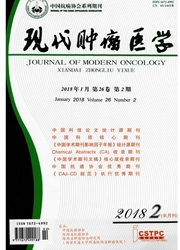

 中文摘要:
中文摘要:
目的:研究诱发性大鼠乳腺癌发生过程中组织形态学变化和肿瘤微血管密度(MVD)。方法:Wistar雌性大鼠85只,SD雌性大鼠22只,配制浓度为10 mg/ml的二甲基苯蒽(DMBA)麻油溶液灌胃大鼠。17只大鼠8周前死亡,剩余90只大鼠从第8周开始至24周,每2周取大鼠10只活杀,观察乳腺外形,取乳腺肿块HE染色和Ⅷ因子相关抗原免疫组化染色。结果:存活8周以上的90只大鼠中,73只成功诱发乳腺肿瘤,其中乳腺良性增生11只,乳腺癌62只。乳腺癌62只大鼠中,浸润性导管癌35只,浸润性小叶癌15只,乳头状腺癌5只,其他类型肿瘤7只。乳腺癌分化程度分级为:高分化5只,中分化36只,低分化21只。乳腺癌MVD平均值为(6.53±2.71)个/高倍视野,乳腺良性增生MVD为(1.67±0.95)个/高倍视野,乳腺癌MVD显著高于乳腺增生性疾病(P〈0.01)。低分化乳腺癌MVD显著高于中、高分化乳腺癌(P〈0.001)。结论:DMBA灌胃Wistar雌性大鼠乳腺癌诱发成功率高,肿瘤分化程度与微血管密度密切相关。
 英文摘要:
英文摘要:
Objective:To observe the microvessel density(MVD) and histomorphological change in the development of induced rat breast cancer.Methods: Eighty-five female Wistar rats and twenty-two female SD rats were administrated intragastrically with 10 mg/ml 7,12-dimethyl-1,2-benzanthracene(DMBA) sesame oil solution.Seventeen rats died within 8 weeks.The remaining 90 rats were sacrificed from 8 to 24 weeks,10 rats every two weeks.Breast tumors were obtained,hematoxylin and eosin(HE) stain and Factor Ⅷ related antigen(Ⅷ-RAg) immunohistochemistry were performed.Results: Breast tumors were successfully induced in 73 rats,of which 11 rats with benign hyperplasia and 62 rats with breast cancer.Within 62 rats with breast cancer,the histological types included infiltrating duct carcinoma 35 rats,infiltrating lobular carcinoma 15 rats,papillary adenocarcinoma 5 rats,and other tumors 7 rats.Breast cancer was well differentiated in 5 rats,moderately differentiated in 36 rats,and poorly differentiated in 21 rats.MVD was 6.53±2.71 pieces/high power field(HPF) in breast cancer,and 1.67±0.95 pieces /HPF in breast hyperplasia.MVD of breast cancer was significantly higher than that of breast hyperplasia(P0.01).MVD of poorly differentiated cancer was significantly higher than that of well and moderately differentiated cancer(P0.001).Conclusion: Breast cancer can be induced in female Wistar rats successfully with DMBA.MVD of breast cancer is significantly associated with tumor differentiation degree.
 同期刊论文项目
同期刊论文项目
 同项目期刊论文
同项目期刊论文
 Feasibility of MR imaging in evaluating breast cancer lymphangiogenesis using Polyethylene glycol-Go
Feasibility of MR imaging in evaluating breast cancer lymphangiogenesis using Polyethylene glycol-Go Optimization of the composition of bimetallic core/shell Fe2O3/Au nanoparticles for MRI/CT dual-mode
Optimization of the composition of bimetallic core/shell Fe2O3/Au nanoparticles for MRI/CT dual-mode 期刊信息
期刊信息
